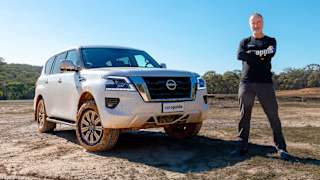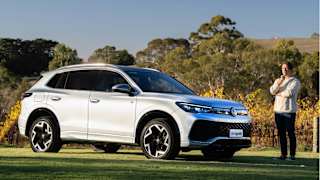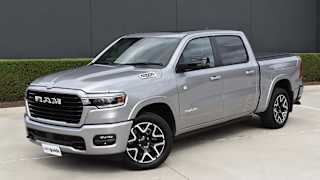At just over 4.9m long, more than 2.0m wide, and a touch taller than 1.5m the V90 CC is a substantial wagon providing seating for five, ample cargo space, and lots of thoughtful touches to help ease the daily grind.
Those in front enjoy heaps of space as well as a centre console incorporating two cupholders, an oddments tray, two USB ports (one to enable Apple CarPlay/Android Auto connection and one for charging only) and a 12-volt socket, all able to be hidden by an elegant, roll-top cover. A similar, smaller cover rolls over a coin tray near the gearshift.
There's also a decent (cooled) glovebox, generous door bins with room for large bottles, and a small lidded box on the lower dash to the right of the steering wheel.
Switch to the rear and the 'roomy' theme continues. Sitting behind the driver's seat set for my 183cm (6.0ft) position I had plenty of leg and headroom, and the width of the car means three average-sized adults can populate the back seat without resorting to uncomfortable contortion.
A centre flip-down armrest houses a pair of pop-put cupholders, an oddments tray and a lidded storage box. But the modest door bins are too narrow for normal size bottles. On the upside, though, parents of small children everywhere will welcome the standard perforated pull-up blinds for each rear door window.
There are also netted map pockets on the back of the front seats, plus adjustable air vents at the back of the centre console and supplementary vents in the B-pillars. Our car's Versatility Pack option added a three-pin 220-volt power outlet at the base of the tunnel console, too.
Then, there's the business end, with the V90 coughing up 560 litres of boot space with the rear seats upright. More than enough to swallow our three-piece hard suitcase set (35, 68 and 105 litres) or the jumbo-size CarsGuide pram, or various combinations of the two.
With the second row 60/40 split-folding rear seat (with through port) down that grows to a substantial 913 litres. And that's measured to top of seat height. If you're loading up to the headlining those numbers stretch out to 723L/1526L.
Plus, there's a 12-volt outlet, bright lighting, a stretchy retaining strap on the right-hand wall, strategically placed shopping bag hooks and tie-down anchors at each corner of the floor.
The Versatility Pack option also adds a 'grocery bag holder' which is a piece of pure Nordic genius. It's essentially a flip-up board that pops out from the cargo floor with two bag hooks at the top and pair of elasticised retaining straps across its width. For small shopping loads it keeps things secure without the need to bring in a full cargo retaining net.
And to make lowering the rear seat and opening up that extra volume easier, the Versatility Pack also brings a pair of power control buttons for rear seat folding located near the rear door.
The space-saver spare is located under the floor, and if you're hitching things to the back, maximum tow weight for a braked trailer is 2500kg and 750kg unbraked.
Icing on the practicality cake is a handsfree power operated tailgate, which combines foot-under-the-rear-bumper auto opening with buttons in the door's lower edge to close it and lock the car.




